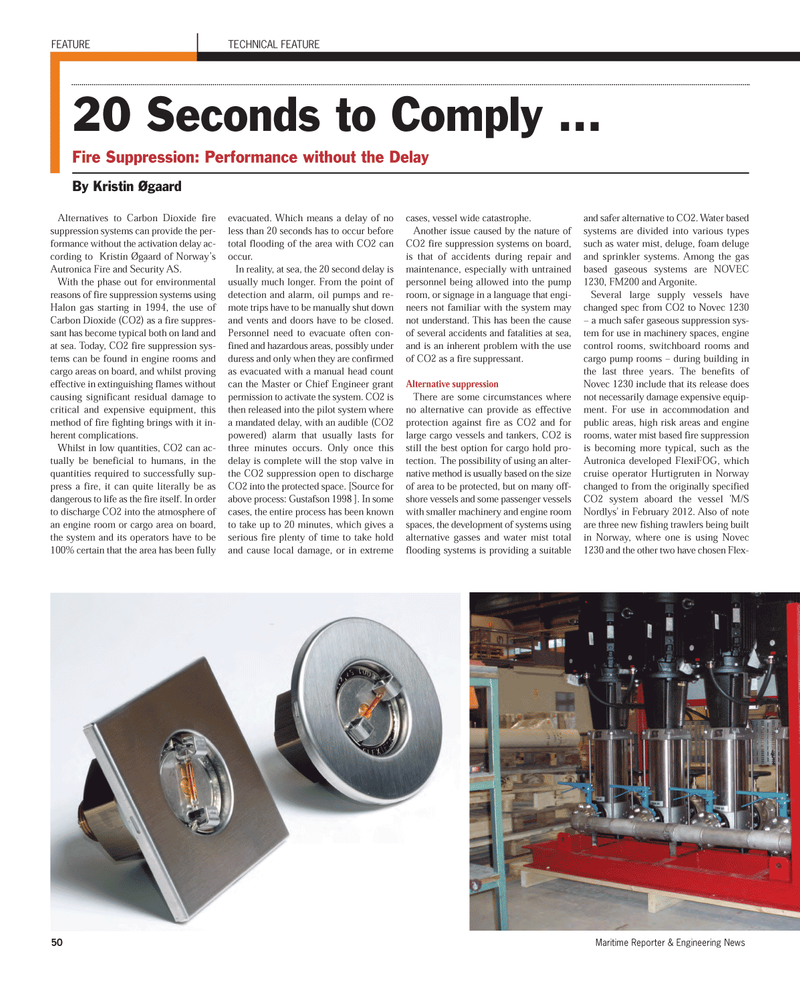
Page 50: of Maritime Reporter Magazine (December 2012)
Great Ships of 2012
Read this page in Pdf, Flash or Html5 edition of December 2012 Maritime Reporter Magazine
50Maritime Reporter & Engineering News FEATURE TECHNICAL FEATURE 20 Seconds to Comply ...Fire Suppression: Performance without the Delay By Kristin Øgaard Alternatives to Carbon Dioxide fire suppression systems can provide the per- formance without the activation delay ac- cording to Kristin Øgaard of Norway?s Autronica Fire and Security AS. With the phase out for environmental reasons of fire suppression systems using Halon gas starting in 1994, the use of Carbon Dioxide (CO2) as a fire suppres- sant has become typical both on land andat sea. Today, CO2 fire suppression sys- tems can be found in engine rooms andcargo areas on board, and whilst proving effective in extinguishing flames without causing significant residual damage to critical and expensive equipment, this method of fire fighting brings with it in- herent complications.Whilst in low quantities, CO2 can ac- tually be beneficial to humans, in the quantities required to successfully sup-press a fire, it can quite literally be as dangerous to life as the fire itself. In order to discharge CO2 into the atmosphere of an engine room or cargo area on board, the system and its operators have to be 100% certain that the area has been fullyevacuated. Which means a delay of no less than 20 seconds has to occur beforetotal flooding of the area with CO2 canoccur. In reality, at sea, the 20 second delay is usually much longer. From the point of detection and alarm, oil pumps and re-mote trips have to be manually shut down and vents and doors have to be closed. Personnel need to evacuate often con- fined and hazardous areas, possibly under duress and only when they are confirmed as evacuated with a manual head count can the Master or Chief Engineer grantpermission to activate the system. CO2 is then released into the pilot system wherea mandated delay, with an audible (CO2 powered) alarm that usually lasts for three minutes occurs. Only once thisdelay is complete will the stop valve in the CO2 suppression open to discharge CO2 into the protected space. [Source forabove process: Gustafson 1998 ]. In some cases, the entire process has been known to take up to 20 minutes, which gives a serious fire plenty of time to take hold and cause local damage, or in extreme cases, vessel wide catastrophe. Another issue caused by the nature ofCO2 fire suppression systems on board, is that of accidents during repair andmaintenance, especially with untrainedpersonnel being allowed into the pump room, or signage in a language that engi-neers not familiar with the system may not understand. This has been the cause of several accidents and fatalities at sea, and is an inherent problem with the useof CO2 as a fire suppressant. Alternative suppression There are some circumstances whereno alternative can provide as effective protection against fire as CO2 and for large cargo vessels and tankers, CO2 is still the best option for cargo hold pro- tection. The possibility of using an alter- native method is usually based on the size of area to be protected, but on many off- shore vessels and some passenger vessels with smaller machinery and engine roomspaces, the development of systems using alternative gasses and water mist total flooding systems is providing a suitable and safer alternative to CO2. Water based systems are divided into various types such as water mist, deluge, foam deluge and sprinkler systems. Among the gas based gaseous systems are NOVEC 1230, FM200 and Argonite. Several large supply vessels have changed spec from CO2 to Novec 1230 ? a much safer gaseous suppression sys- tem for use in machinery spaces, enginecontrol rooms, switchboard rooms andcargo pump rooms ? during building in the last three years. The benefits of Novec 1230 include that its release does not necessarily damage expensive equip- ment. For use in accommodation and public areas, high risk areas and enginerooms, water mist based fire suppression is becoming more typical, such as theAutronica developed FlexiFOG, which cruise operator Hurtigruten in Norway changed to from the originally specified CO2 system aboard the vessel 'M/S Nordlys' in February 2012. Also of note are three new fishing trawlers being built in Norway, where one is using Novec 1230 and the other two have chosen Flex- MR#12 (50-57):MR Template 12/5/2012 12:37 PM Page 50

 49
49

 51
51
